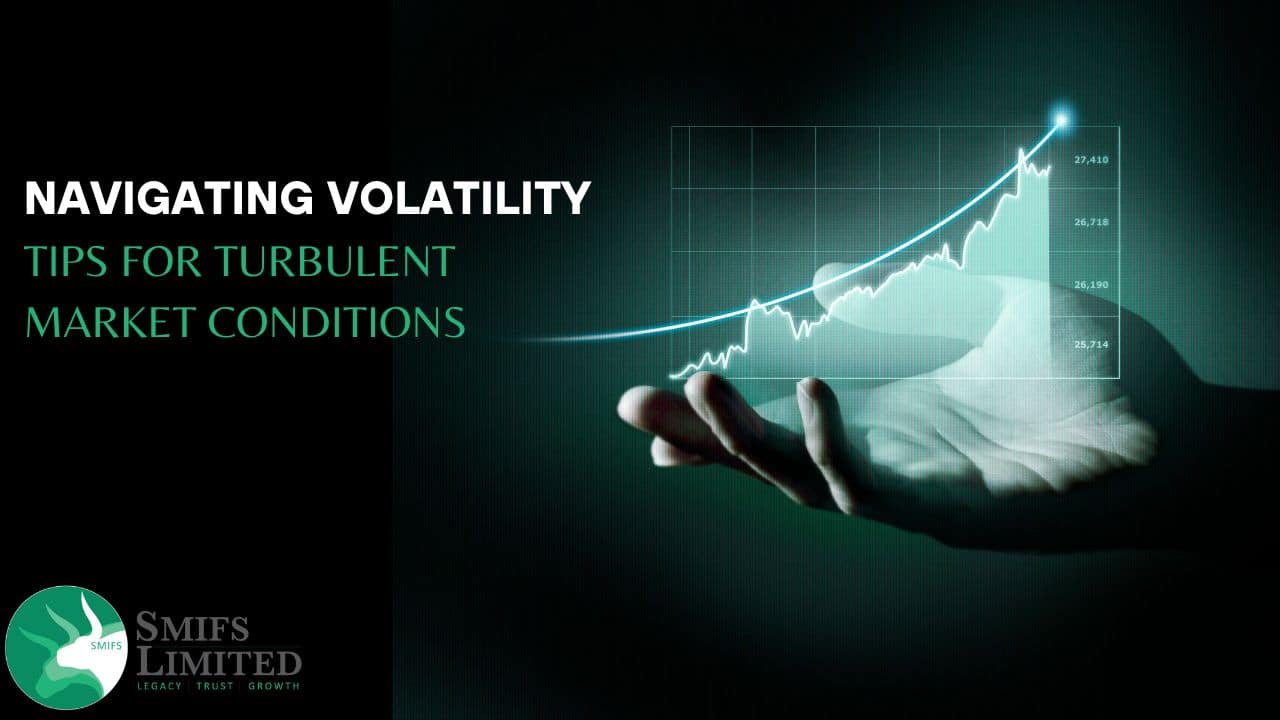One factor that never changes in the fast-paced world of finance is navigating volatility.

Recognizing the volatility of the markets
Something is only preventable if you know what it is. We shall thus begin by explaining market volatility to you in plain terms. A market’s or security’s propensity to abruptly rise or fall in a brief amount of time is measured statistically as volatility. The standard deviation of an investment’s return over a given time period is usually used to quantify it. The amount that the price of a financial asset, such as a stock, varies or fluctuates over a given time period is referred to as market volatility. It gauges the extent and speed at which prices fluctuate in the market.
Causes of Market volatility
Here are a few reasons why markets fluctuate:
- Economic Indicators: Market volatility can be greatly influenced by economic data, including GDP growth, employment figures, inflation rates, and consumer mood. Market fluctuations might be abrupt if there are positive or negative surprises in these data.
- Geopolitical Events: Tensions in the geopolitical sphere, trade disputes, and political instability can all lead to uncertainty and market volatility.
- Earnings Reports: The volatility of the market as a whole can be influenced by company earnings reports and guidance, which in turn can affect the stock prices of specific firms.
- Interest Rates: The financial markets can be greatly impacted by shifts in interest rates and central bank policy. Market swings can result from monetary policy decisions that impact consumer spending, investment choices, and borrowing rates
- Worldwide occurrences: Unexpected occurrences, pandemics (such as COVID-19), and natural calamities can jar markets and spark sharp price swings.
The emotions and views of market participants regarding the economy and financial markets have the potential to cause volatility. This is known as investor sentiment. Price swings can be made worse by greed, fear, and herd mentality.
How can the volatility of the market be measured?
Using statistical measures such as these, investors can measure market volatility:
Norm Deviation: This quantifies the range of a collection of data points from the average (mean). Within the financial domain, it signifies the extent to which the values of a financial instrument have diverged from their mean value during a given time frame.
Beta: A measure of an asset’s price movement in relation to the market as a whole is called beta. A beta of one means that the stock price moves in lockstep with the market; on the other hand, a beta of less than one denotes lesser volatility and a beta of greater than one indicates higher volatility.
Volatility Index (VIX): Also referred to as the Fear Index, the VIX measures market participants’ predictions for short-term market volatility.
Tips for turbulent market conditions and navigating volatility
Learn for Yourself: In volatile markets, information is your greatest ally. Invest some time in learning about economic indicators, market dynamics, and the variables affecting volatility. You can be better equipped to make decisions if you comprehend the fundamentals of the market as a whole and the equities you hold.
Educated yet Not Overbearing: While keeping up with market changes is crucial, making snap decisions might result from becoming overly engrossed in the daily news cycle. Instead, focus on understanding the wider picture. Factors such as industry trends, economic indicators, and company fundamentals offer a strong foundation for making informed decisions.
Make your objectives, risk capability, and risk tolerance clear
First and foremost, it is essential to have specific investment goals. These objectives, which can include buying a property, paying for schooling, or saving for retirement, can change based on the specifics of each situation. Investors can set a target and create an investment plan that is in line with those aims by making clear what those precise goals are.
Second, it’s critical to comprehend one’s risk tolerance. The term “risk tolerance” describes how comfortable a person is with changes in the value of their investments. While some people choose a more conservative strategy, others may be more willing to take on larger amounts of risk in exchange for possibly higher rewards. Determining the right combination of investments that corresponds with a person’s comfort level is made easier by evaluating risk tolerance.
Finally, it is critical to evaluate risk capacity. Risk capacity takes into account a person’s income, assets, liabilities, and time horizon, among other financial factors. It establishes the level of risk that a person can afford to take. Longer-term investors and those in stable financial condition may be more able to take on risk, which enables them to commit more capital to possibly riskier ventures.
Being knowledgeable and modifying your approach to investing
First and foremost, it’s critical to keep up with current events, economic situations, and market trends. Keeping a close eye on economic statistics, industry reports, and financial news can give you important insights about the state of the market. Investors that keep themselves updated are better able to make decisions and modify their investment plan in light of new knowledge.
Second, analyzing and reevaluating market circumstances and portfolio performance on a frequent basis is necessary when making adjustments to an investing strategy. Through this procedure, investors can make sure that their holdings continue to reflect their objectives, level of risk tolerance, and market conditions. Rebalancing asset allocations, adjusting for a particular industry, or taking new investment opportunities into consideration are some examples of modifications.
Apart from that, it’s critical to consider the big picture when making adjustments to an investing strategy rather than acting impulsively in response to transient market swings. Making snap decisions can result in less than ideal results because market volatility is a normal aspect of investing. On the other hand, concentrate on the basic principles of investing and base changes on a well-planned plan.
Finally, excessive frequency or being influenced by transient market noise should not be the basis for routine monitoring and modification. Achieving a balance between preventative measures like excessive trading and reactive decision-making and proactive monitoring is fundamental. In the long run, improved results can result from a rigorous and knowledgeable approach to modifying the investment plan.
Adopting a Long-Term Perspective
Taking a long-term view is the first step in managing market volatility efficiently. In the long run, short-term market fluctuations are insignificant fluctuations in your financial journey. Despite sporadic downturns, historical trends show that markets often grow over time. Focusing on long-term objectives will help you stay away from snap decisions prompted by transient market noise.
Diversity: Your Protective Gear Against Uncertainty
One of the best defenses against the effects of market volatility is diversification. You can reduce risk by distributing your assets among different asset classes and industries. A thriving industry could benefit from volatility in another, balancing your portfolio overall. This diversified strategy keeps you on course and mitigates the impact of market swings.
Periodically review your portfolio to ensure it aligns with your investment goals. Assess whether changes in market conditions or the performance of specific stocks warrant adjustments to your holdings. Rebalancing your portfolio can help you stay on track.
Steer Clear of Emotional Decision Making
Impulsive behavior might result from making decisions based on emotions. Emotions can impair judgment, whether they be fear during market downturns or enthusiasm during rallies. Adhere to your financial strategy and base choices more on facts and reasoning than feelings.
Think About Expert Counsel
Professionals in finance can offer insightful counsel if market volatility is causing you to feel uncertain. Financial advisors can assist you negotiate difficult market conditions and provide advice customized to your situation.
In summary, a demat account must be used in conjunction with education, self-control, and a strategic attitude for new investors to effectively navigate market turbulence. You may successfully navigate through challenging times and set yourself up for long-term success in the ever-changing world of stock market investing by remaining knowledgeable, diversifying your portfolio, and maintaining a long-term view. Recall that market turbulence is a natural part of the investing process, and addressing it with a thoughtful approach can eventually yield profitable results.
|
Core Insights
|







